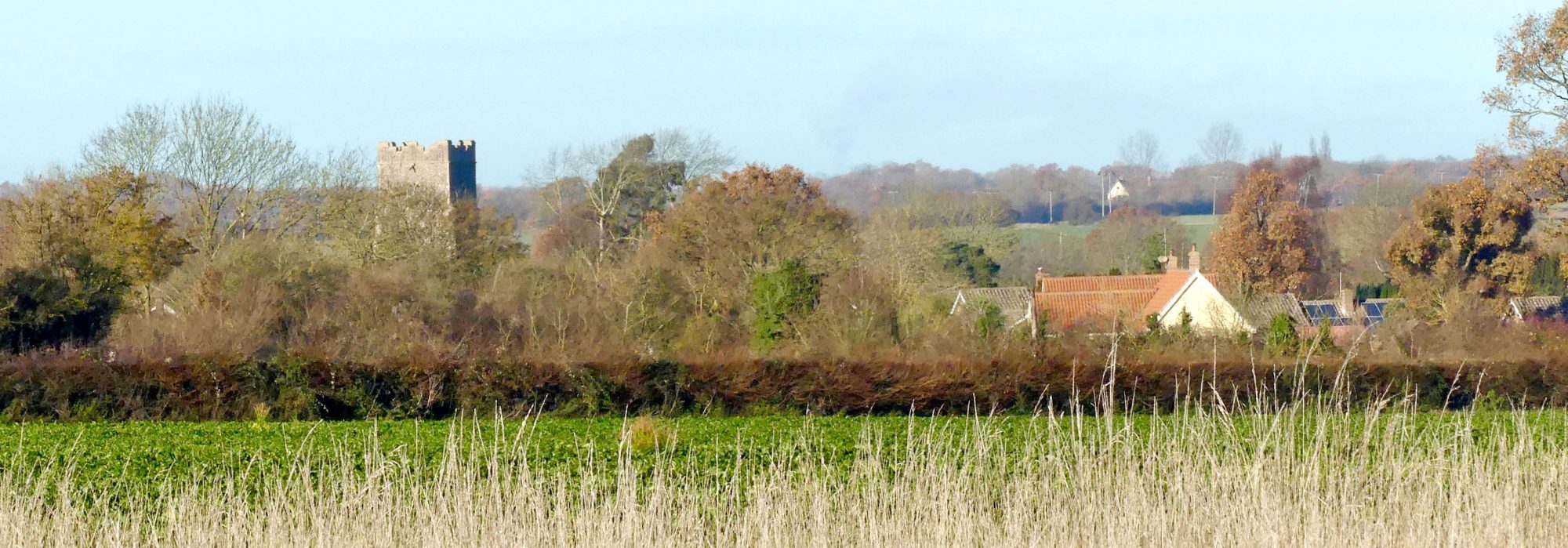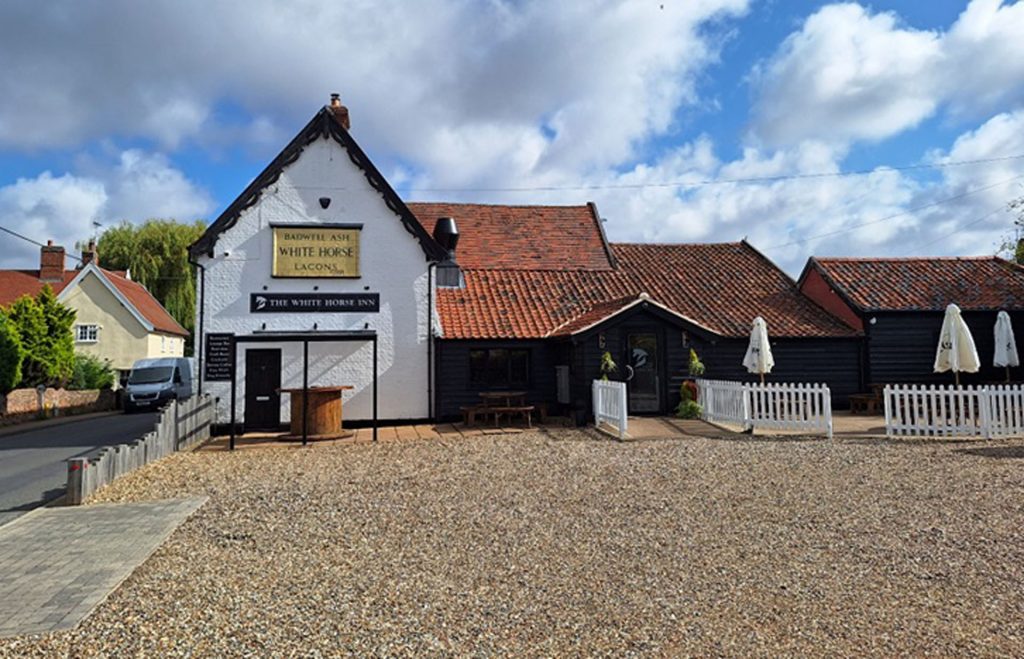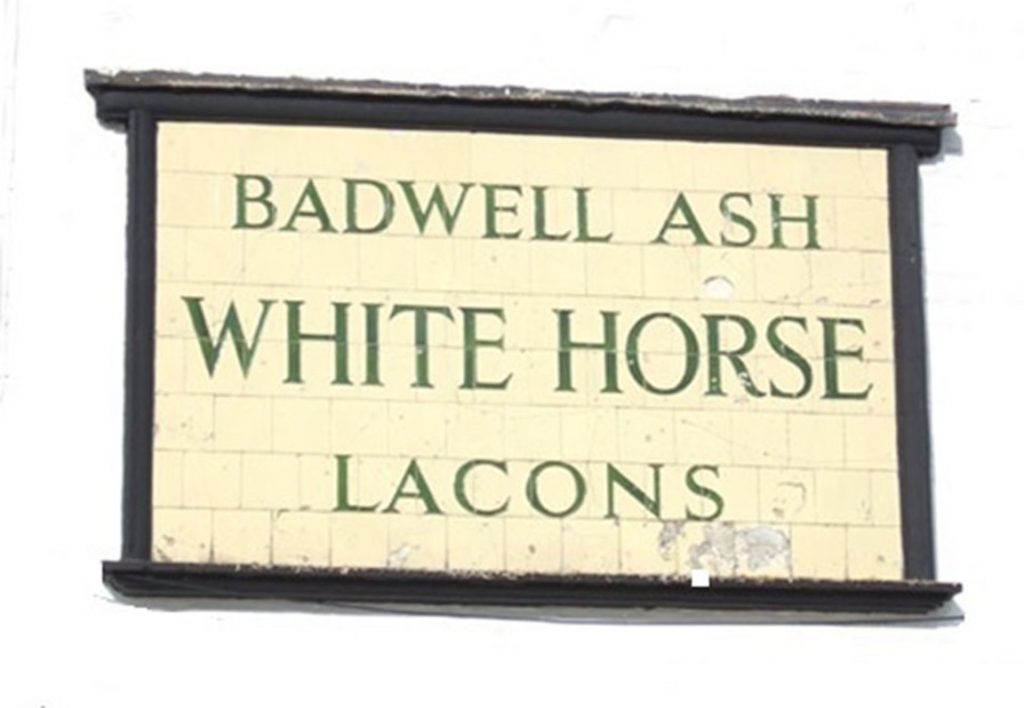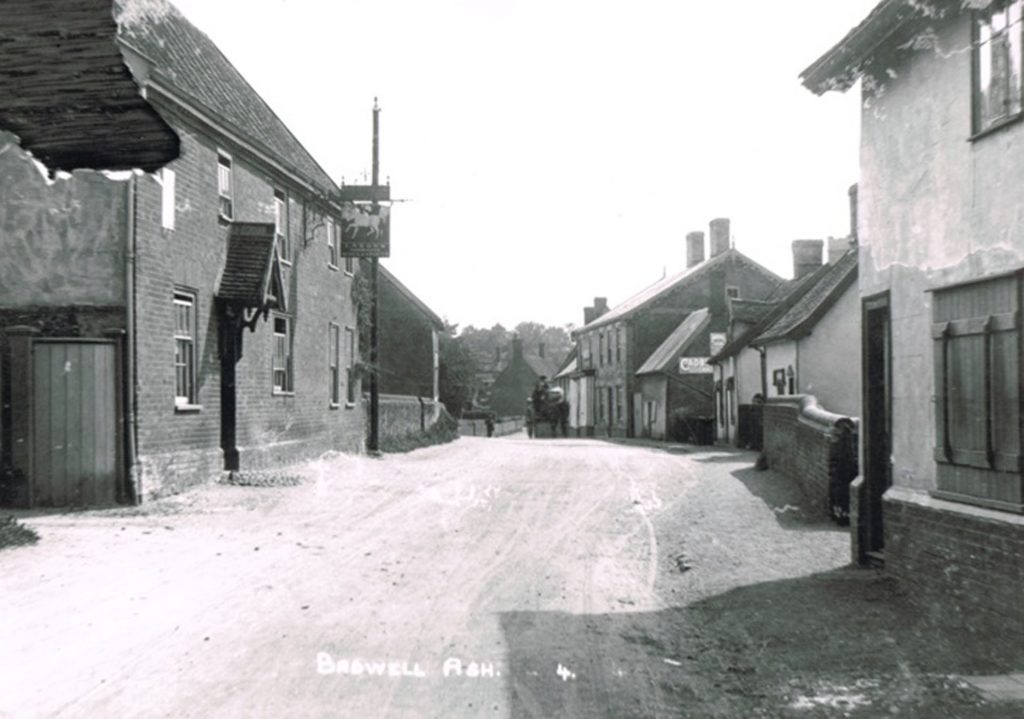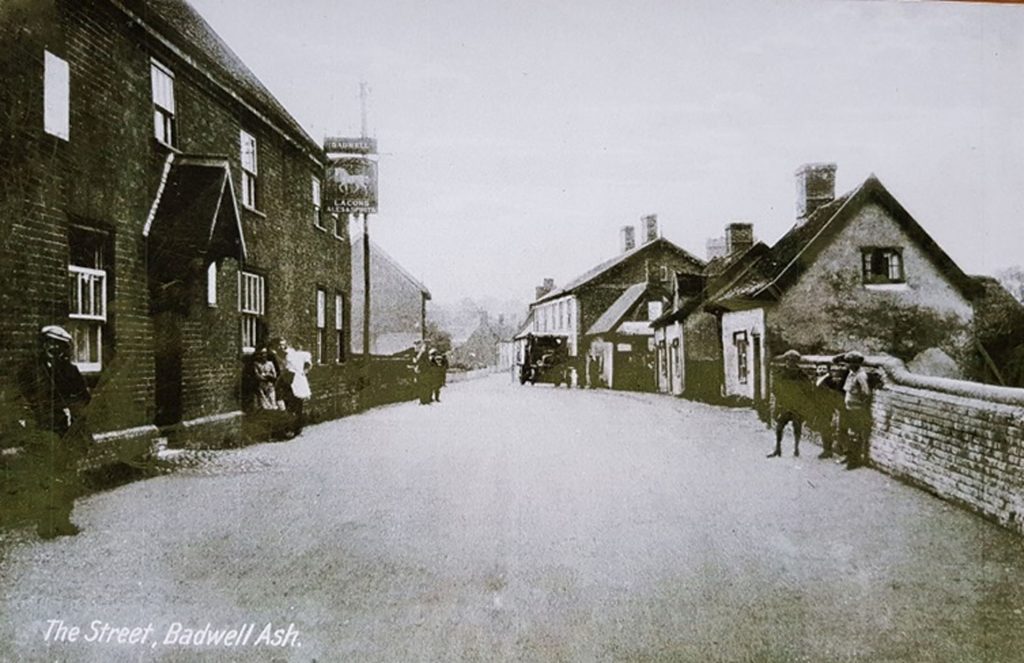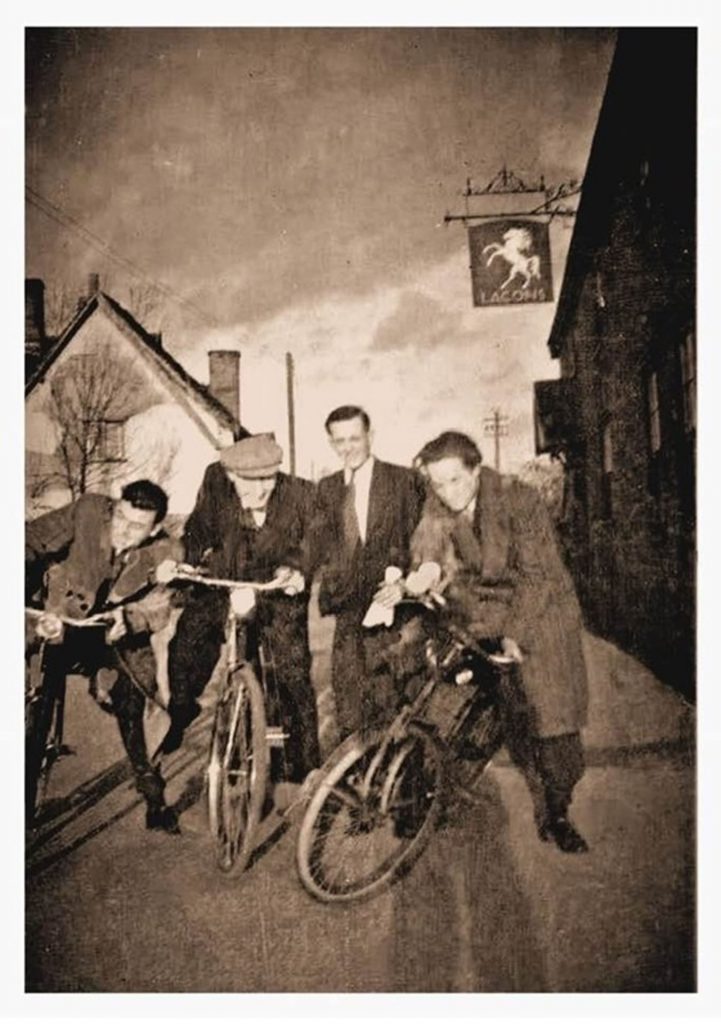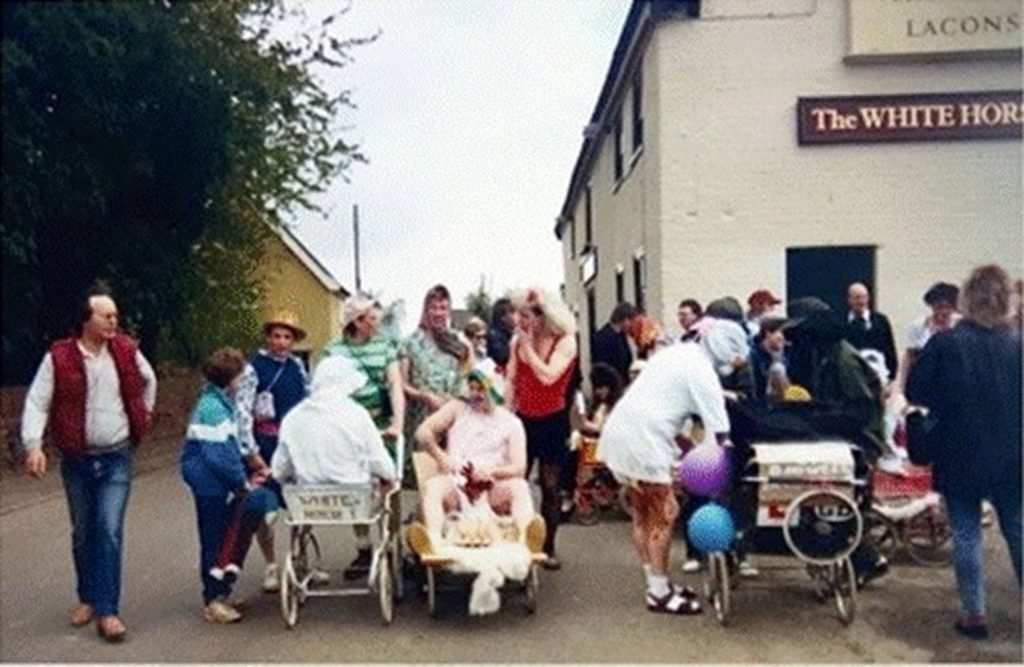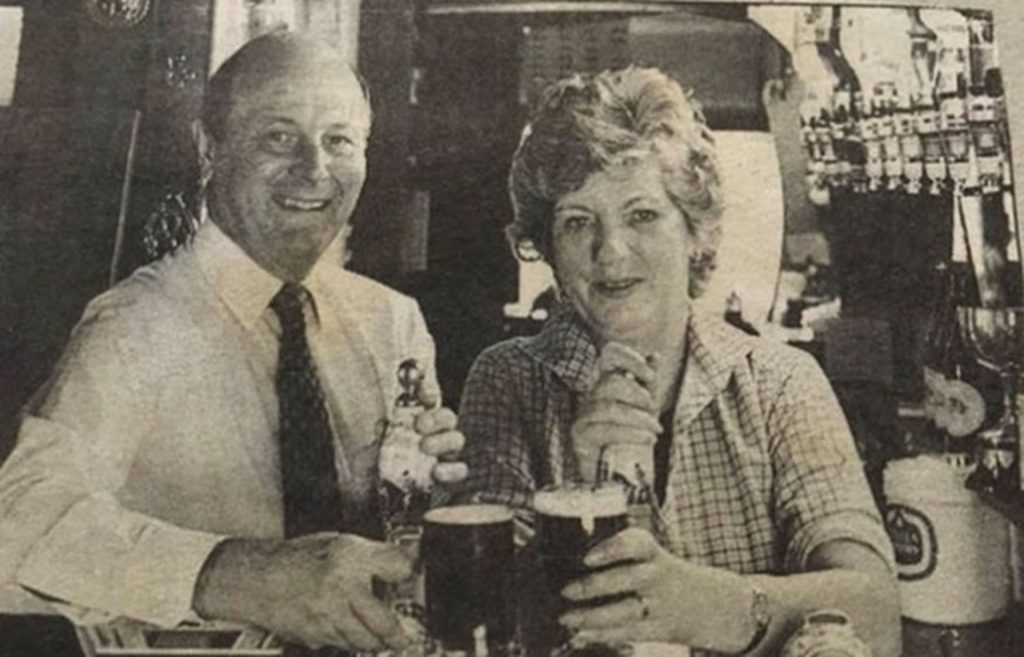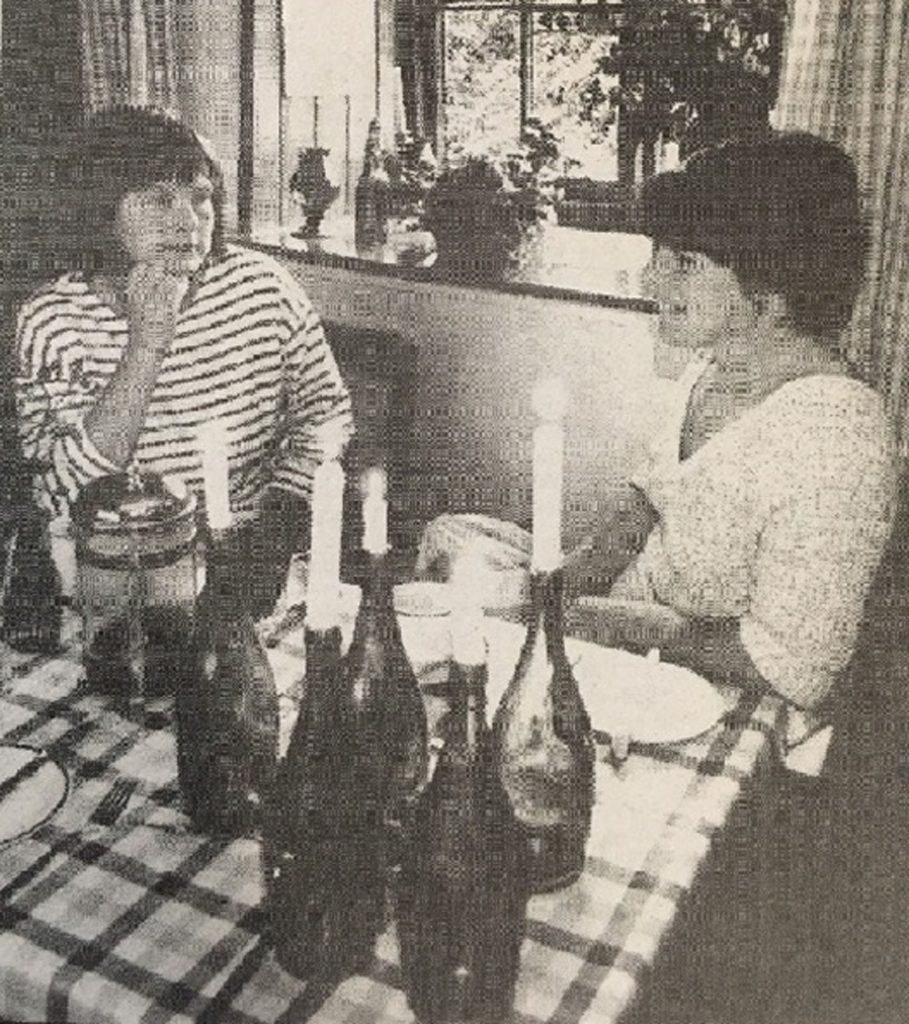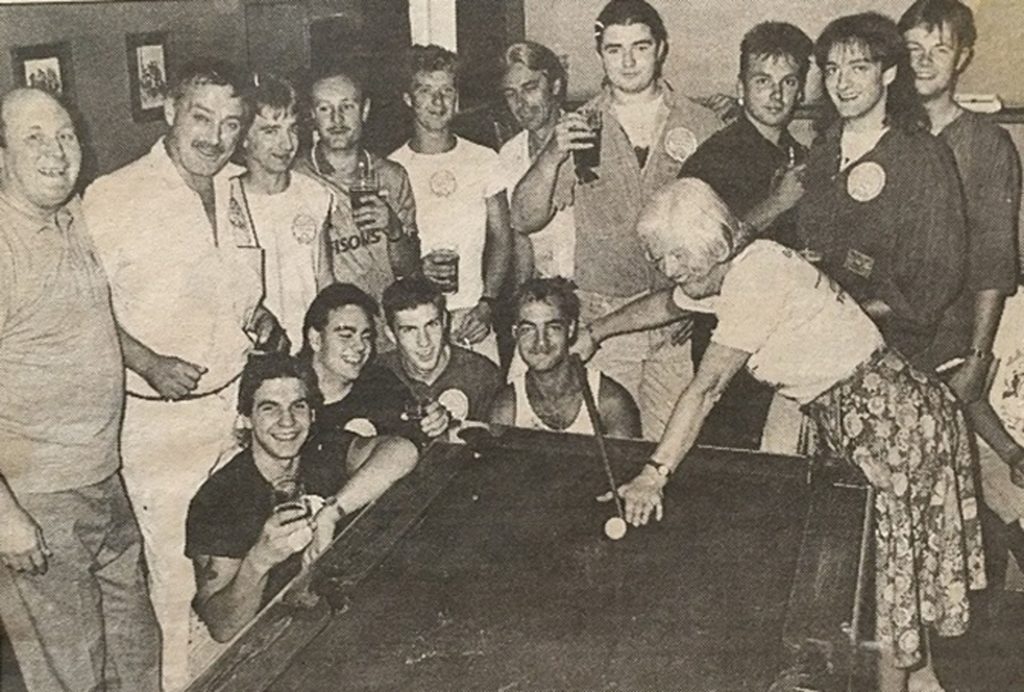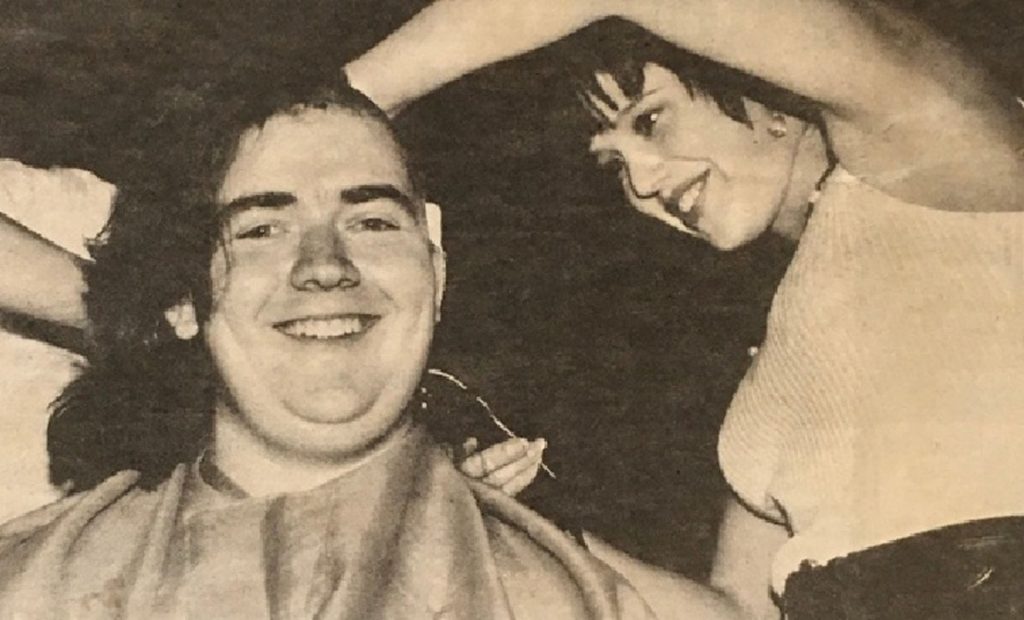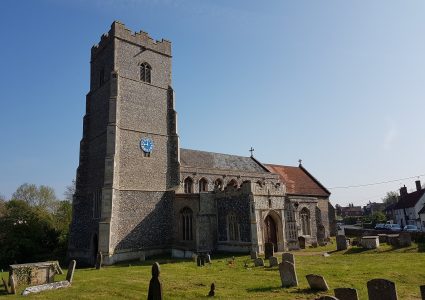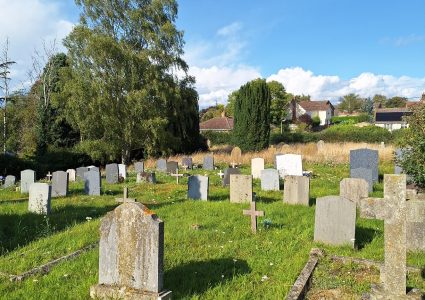1.The White Horse Inn Today
There has been an Inn on this site since a building was erected in the C16, almost 500 years ago. Although the building is now clad in red brick, probably added in the C19, the original Tudor building can still be seen inside. Part of the Tudor timber framed structure with some very fine double roll-mouldings on the main cross-beams can be seen on the ceiling in the Lounge/Cocktail Bar.
The building was Listed as a Grade II structure in 1955. According to the Listing, there is evidence to the timber frame in the attics that the original building did not have a chimney, but simply a hole in the roof known as a “smoke bay” to let the smoke out! The chimney was probably inserted in the C16.
Over the years, the interior of the building has undergone many transformations with the latest refurbishment having been carried out just a few years ago by the current owners.
The earliest record of The White Horse Inn either in the Archival Records or the newspapers is an advertisement from 1727 in The Suffolk Mercury which was advertising the sale of the pub, and all its beer! There are many similar “For Sale” and “To Let” advertisements from newspapers, some of which have now gone out of print including the Ipswich Journal, The Bury and Norwich Post, The Bury and Norfolk Post and Suffolk Herald and The Newmarket Journal. The Bury Free Press and East Anglian Daily Times date from 1782 to currently.
Until 1925, when a new law was introduced, the Inn was bought and sold as a Copyhold property. Only Manorial lands could be held freehold, a tradition dating back to feudal times. All other smaller landholdings within Manors were held under the Copyhold tenure, a form of leasehold, with the rent being paid to The Lord of the Manor, which in this case would have been the Lord of the Manor of Shakerland Hall. During the C19 many Copyholds became virtual freeholds such as 999-year leases but in 1925 all Copyhold land was abolished and the land was enfranchised into Freehold.
The Inn was owned by various individual Copyholders up until 1837 when John Miller, who was brewer from Walsham le Willows, acquired the Copyhold title of the Inn. In 1876 he sold The White Horse together with 5 other public houses and the brewery in Walsham to Taylor, Sons and Dowson of Diss, who were also Brewers. In 1897, Tollemache Breweries Ltd from Ipswich bought Taylor, Sons and Dowson and all their public houses but a year later, they sold all these properties to E. Lacon and Sons of Great Yarmouth. The Lacons sign can be seen on the gable end of the pub today.
- The C19 White Horse Inn Sign
©: Suffolk CAMRA
In 1957 Whitbread and Co bought a 20% share in Lacons and bought all the remaining shares in 1965. Whitbreads closed the Lacons Brewery in Great Yarmouth in 1968 and it was then demolished.
A schedule of Owners/Landlords since from 1735 to 1804 is shown below. No records of ownership prior to 1735 have been discovered. Very little is known about some of these earlier owners. Most of the earlier research has been carried out by researching Epitomes of Title and Deeds held in The Suffolk Archive and, although these show the amounts paid for the pub when bought and sold, there’s no information about the individual Landlords until the early C19 and the Landlord in 1804, John Clarke.
John Mason – 1735 to 1749
We know that John Mason married an Elizabeth Rowland from Wetherden in 1741 but we have no other information about this gentleman.
Robert Garnham – 1749
An Abstract of Title of 1851 states that Robert Garnham sells The White Horse to Thomas Quantrill Snr, blacksmith for £100 (£17,000 in todays’ money). Robert is buried in St. Mary’s churchyard. He died in 1769. (©:From Essex and Suffolk surnames)
Thomas Quantrill Snr. 1749 to 1754
An Abstract of Title of 1851 states that Thomas Quantrill Snr, who was a Blacksmith and the Copyholder, sold The White Horse to John Richards, a shopkeeper from Hunston for £200 (£34,000 in todays’ money). Thomas Quantrill is buried in St. Mary’s churchyard although no headstone exists today. He died in 1771. (©:From Essex and Suffolk surnames)
John Richards 1754 to 1776
Very little is known about John Richards other than the Epitome of Title from 1851 tells us that he died in 1779, but not in Badwell Ash.
Alex Moss – 1776 to 1779
Again, very little is known about Alex Moss other than the Epitome of Title from 1851 and an announcement in the Ipswich Journal 1776 which said: “The Petty Sessions for the Hundred of Blackbourne will be held at The White Horse at Badwell Ash on Friday 4th October next for hiring and removing of servants by order of Robert Grimwood and Thomas Garnham (Chief Constables). N.B. Proper stall-stuff will be provided and a good ordinary at the Inn at One o’clock. By their humble servant Alex Moss.”
Cyril Quantrill – 1779 to 1780
The Epitome of Title from 1851 tells us that the sale of the copyhold of The White Horse Inn to Cyril Quantrill for £260 (£38,000 in todays’ money) by Thomas Quantrill Jnr and William Quantrill as executors of the late Thomas Quantrill Snr. That would seem to imply that Alex Moss was Thomas Quantrill’s undertenant.
William Rose – 1780 to 1791
The Epitome of Title from 1851 now tells us that there was a sale to William Rose as undertenant by Cyril Quantrill Jnr for £550 (£55,500 in todays’ money). William Rose is buried in St. Mary’s churchyard in a large chest tomb next to the priests’ door with Diana Rose, his wife, together with Samuel and Emma Parker.
William Raffe – 1791 to 1804
William Raffe purchased the White Horse Inn from Cyril Quantrill for £880 (£108,000 in todays’ money). He was mortgaged to Joseph Rasson of Stowlangtoft for £200 (£24,000 in todays’ money) and to William Rose of Badwell Ash for £250 (£31,000 in todays’ money. Unfortunately, nothing more is known about William Raffe.
John Clarke – 1804 to 1811
An advertisement in The Ipswich Journal of March 1802 stated: To be sold on Mar 16. That good accustomed brick & sash-fronted PUBLIC-HOUSE, known by the name of the White Horse, in Badwell Ash…comprising a kitchen, bar, 3 parlours, 7 chambers and garrets over the same, a back house, pantry, storeroom, cellar & wine vaults; also, a compact new built brewhouse, with excellent water; stables, chaise-house, liquor warehouse, corn chamber and other convenient outbuildings, together with a neat garden, walled-in and planted with choice fruit trees. The premises are in excellent repair and in a most desirable situation. John Clarke was the successful bidder at £500 (£41,000 in todays’ money).
John Clarke was the owner of the Capital Brewery in Guildhall Street, Bury St. Edmunds. In approximately 1799, Clarke took on a Benjamin Greene, who had been apprenticed to Whitbread in the 1790s, as an assistant brewer on a three-year contract. Greene would go on to found the company which eventually became Greene King. On Clarke’s death in 1811, his Executors sold the premises to John Gallant who had taken over The Capital Brewery with John Stutter. The Capital Brewery would eventually close in 1837.
John Gallant – 1813
John Gallant became the owner of The White Horse in 1813 after the death of John Clarke. John Gallant together with John Stutter of Fornham St Martin were brewers who took over the ownership of the Capital Brewery in Westgate Street, Bury St. Edmunds after John Clarke had died in 1837 together with its associated pubs including The White Horse in Badwell. In 1799, John Gallant employed a certain Benjamin Greene as head brewer. Green King’s head office and brewery are still situated in Westgate Street today. After the purchase of The White Horse, in less than 12 months Gallant sold it to Simon Kinsey and John Frost.
Simon Kinsey and John Frost – 1813 to 1829
Simon Kinsey seems to have a chequered career as the Landlord of The White Horse. He first became Landlord jointly with John Frost in 1813, having acquired the pub from John Gallant. It seems, Kinsey required Frost as a guarantor/partner in order to raise sufficient funds to acquire the property from Gallant.
Simon Kinsey – 1829 to 1837
John Frost died in 1829 and his Executors sold The White Horse to Simon Kinsey, the existing publican for £1,200. Kinsey had mortgaged the pub for the sum of £1,000 to Samuel Bignold of Norwich. Samuel’s father, Thomas Bignold was the founder of The Norwich Union and Fire Insurance Society and Samuel followed in his father’s footsteps. Unfortunately, Kinsey failed to maintain the mortgage payments and Samuel Bignold foreclosed on the mortgage in 1837. The property was then auctioned and purchased by a John Miller.
John Miller – 1837 to 1839
An advertisement in The Ipswich Journal on 28th August 1837 stated “Copyhold Estate: The White Horse Inn, Badwell Ash, to be sold by Auction…Let to Mr John MILLER, Maltster, for a term of which 6 years were unexpired on the 28th August 1837 at a rent of £50 p.a. The Estate is copyhold of the Manor of Shackerland, in Badwell”. John Miller who was a brewer from Walsham Le Willows, purchased The White Horse for £500, considerably less than Kinsey had paid for it some 8 years earlier! Although Miller was The Copyholder (owner), Kinsey is shown as being the Innkeeper in the 1841 Census. We can only assume that Miller decided that the easiest way to run the pub was to utilise the services of the existing Landlord, Kinsey who became an Undertenant.
Simon Kinsey – 1839 to 1852
The earliest reference to Simon Kinsey being reinstated as the pub Landlord is 1839. This is contained within the Tithe Assessment for Badwell Ash of 1839 where Kinsey is shown as paying an annual Tithe of 1s 6d (8p in todays’ money). A Tithe was a tax on land with the proceeds being given to the church. The Tithe dates back to feudal times when people gave goods and services to the church. By the early 1800s, all Tithes had been converted to a monetary tax and the assessment of 1839/41 was a national assessment to establish who was responsible for what and included the first accurate detailed map of all land holdings and their owners and occupiers. The occupier of the land or property was responsible for the payment of this tax.
Although shown as being head of the household on the 1851 Census, Kinsey died penniless in 1852 in Heigham Hall Lunatic Asylum, Norwich, Norfolk after again being declared bankrupt! Bankrupts were treated as criminals and locked away in debtors’ prisons until the 1870s when these prisons were abolished. However, bankrupts were often deemed to be mentally ill and, as Kinsey had been bankrupted twice, he unfortunately ended his days in a Lunatic Asylum. He is buried in St. Mary’s Churchyard next to his wife Susan and daughter Mary, who died in 1827 aged just 19.
In The Ipswich Journal of June 1851 there was advertisement which stated: For sale, The White Horse Inn, Badwell Ash. In the occupation of Mr John MILLER or his under-tenant, Mr Simon KERSEY. There is no other Inn or Beer Shop in the Parish” Obviously, the paper incorrectly misstates Kinsey’s name as Kersey!
1852 – 1855
Unfortunately, there’s no record of who was running the pub during this period.
William Jackaman – 1855 to 1879
Jackaman was the Landlord at the White Horse for over 24 years. A year after he became landlord, his wife Susannah aged only 33 died leaving him with five children to look after.
The 1861 census shows William as the head of the household with all his 5 children, aged 8 – 17 living with him, plus his mother-in-law who was acting as the housekeeper. His 17-year-old daughter Susannah was working as a dressmaker, his 15-year-old son George was a carpenter’s apprentice and his 14-year-old daughter Ellen was working in the pub as a barmaid.
It was reported in the Ipswich Journal of 1875 that Jackaman had been summoned by the Stow Guardians to explain why he should not contribute a sum of 6s (30p) towards the maintenance of his son, George who was confined in the County Lunatic Asylum, at Melton, near Woodbridge. It would seem that George, who had been training as a carpenter’s apprentice, had subsequently been confined to the lunatic asylum. The Stow Guardians told William that the average cost of George’s maintenance, now aged 30, was 10s 6d (53p) per week. William offered to pay 2s 6d (12.5p) stating that he could pay no more having an aged mother-in law, Susannah Adams, now aged 70 to keep, a new wife Harriet aged 44 who had just given birth to twins, and he was suffering with scrofula, a form of tuberculosis which affects the lymph nodes in the neck. The Guardians were sympathetic but expressed an opinion that he should pay 4s (20p) per week, and this was agreed.
In 1876, it was reported in the Bury Free Press that Jackaman had served beer during prohibited hours. It seems that Harry Morley, William Major and John Spink were seen by Constable Gildersleeves being served and paying for beer by Jackaman’s wife Harriet at 7-o-clock on a Sunday morning. He was fined £3 with costs of 5s 6d (28p) and was told that a further offence would mean he would lose his Licence.
On 30th March 1878, Jackaman decided to leave the pub and an auction of furniture, wines and bottled beers was advertised in the Bury Free Press on 30th March. By now, Jackaman was aged 60. His decision to vacate the pub may have been influenced by the sale of the Copyhold in 1876 by John Miller who sold his brewery at Walsham le Willows with all its tied pubs to Taylor, Sons and Dowson of Diss, Brewers. Perhaps they increased the rent?
William Smith – 1879 to 1881
William Smith is shown as being Landlord in 1879 in Kelly’s Directory, but he had vacated the pub by 1881. But by 1881, the census shows the Licenced Victualler or Landlord of the pub as being a William Baker.
William and Selina Baker – 1881 to 1882
William, aged 30 and his wife Selina aged 24 are shown in the 1881 census as being the Landlords of The White Horse, living there with their son William aged 4. However, their tenure was very short as Kellys and The Post Office Directories and The Electoral Roll show James Roberts as being Landlord a year later in 1882.
3.The White Horse Inn in late C19
James, Susan and Linda Roberts – 1882 to 1915
Between them, the Roberts family were landlords at the White Horse for over 33 years. In the 1891 census James is shown as being the” Victualler”, aged 38 and living in the pub with his wife Susan aged 39 and with Linda, their daughter aged 24. So, when James took over the pub, he was just 30 years old. The 1891 census also tells us that Linda was working in the pub. Also working and living there were Lewis Nice aged 37, an Ostler (someone who looks after horses for people staying at the Inn) and James Nice aged 34, who was Lewis’ brother.
Between 1882 and 1915 there was a change of tenant with the Landlords variously shown as James Roberts, Susannah Roberts or Linda Roberts or a combination of each of them. This could be as a result in several changes of ownership during this period. In 1897 Tollemache Breweries Ltd of Ipswich purchased Taylor, Sons and Dowson then in 1898 Tollemache Breweries Ltd sold the former Taylor, Sons and Dowson Breweries to E Lacon and Sons of Great Yarmouth. Lacons continued as the owners of the Pub until 1968 when they were absorbed into The Whitbread pub chain.
In The East Anglian Daily Times of January 8th 1915 there was an advertisement which read: “To Let: The White Horse, Badwell Ash through the death of the tenant – Immediate possession-for full particulars apply E Lacon and Co Ltd”. It seems that James Roberts had died and the pub was being re-let.
4.The White Horse In at the turn of the C20
Aaron Durrant – 1915 to 1923
Durrant became the new Landlord. In December 1917, it was reported in the Stowmarket Weekly Post that Durrant’s grandson, Alfred, was involved in an incident at work where he was assaulted by a fellow employee. Both Alfred and the other employee a George Osbourne, were employed by Walter Nicholson of Brook Farm, Badwell Ash. Osbourne, struck Alfred on the head with a basket that contained a bottle after reprimanding him for dropping the horse harness in the manure. The bottle broke and cut Alfred’s head open so that it required several stitches. Osbourne took Alfred back to his grandfather, Aaron, and tried to deny any responsibility. He then admitted he had carried out the assault and offered Durrant money if he would not say anything. Despite this, Alfred’s grandfather reported it to the police who charged him with unlawful assault. The magistrate found Osbourne guilty and fined him £1, including costs. Durrant vacated the pub in 1923 and died in 1931.
Alfred William Smith – 1923 to 1928
Smith became Landlord on 1st January 1923. Then in 1928, the licence is transferred to Montague Taylor.
Montague Taylor – 1928 to 1931
Taylor became landlord of the pub but only stays for 3 years until Alfred Smith takes over the tenancy again.
Alfred William Smith –1931 to 1948
After Montague Talor decided to vacate the pub, Alfred Smith becomes landlord again in 1931. He is shown as living there in the 1939 register aged 55 with his wife, Louisa aged 59 and their son, Jack, who was registered as being in the RAF and was a Fitter second class (E) and based at RAF649302 6 squadron TT Hednesford (No 6 School of Technical Training). It was reported in the Bury Free Press from 2nd February 1945 that Jack was instrumental in trying to rescue a family of four from a burning house that had been destroyed by a bomber that crashed into a property in the Midlands. Despite all his best efforts, and being injured himself, he failed to rescue a mother and two children but saved the father.
In October 1935, it was reported in the Bury Free Press that Smith was convicted of careless driving at Stowlangtoft when the car he was driving was in collision with a lorry. He was fined £1 and had his licence endorsed.
5.Left to right Peter Howlett, Marty Smith, Lut Largent and George Whitton Boxing Day 1947
1948 to 1953
Unfortunately, there’s no record of who was running the pub during this period.
Arthur James Harper – 1953 to 1955
Harper seems to have been Landlord of the pub for 7 years but very little is known about him.
J Manning – 1955 to 1964
In an article in The Bury Free press dated 6th November 1964. It was stated that Mr Carter (see next) succeeded Mr. J. Manning. Unfortunately, nothing more can be found about this gentleman.
Jim Carter – 1964 to 1985
In the article in The Bury Free press dated 6th November 1964 it states: New face behind the Bar at The White Horse Badwell Ash is the new Licensee Jim Carter. Mr Carter, who is married, comes from Maidstone, Kent. He succeeds J Manning.
Ron and Lynn Eskdale – 1985 to 1992
After Jim Carter left the pub, the Landlords became Ron and Lynn Eskdale. During their time at the pub, a pram race was held to raise fund for charity with contestants racing around the village and drinking pints of beer at every stop! It’s reported that a good time was had by all!
- Pram Race 1987
Mike and Anne Welham – 1992 to 2005
- Mike and Ann Welham behind the Bar
Mike and Anne Welham took over The White Horse from Ron and Lynn Eskdale in 1992 and were the landlords of the pub until 2005.
During this period, it was reported in the Bury Free Press of the 6 November 1992, in an article, entitled: ‘Friends Find a Recipe to Beat the Recession’ that the Landlords of The White Horse, Mike and Anne Welham, provided a room within The White Horse for a venture by Sally Harrison and Linda Wixley. They sourced local second-hand furniture, received donated items and borrowed and made furnishings to add to the feel of their ‘relaxed continental style’ cafe named ‘The Dark Horse’.
8.Sally Harrison and Linda Wixley who founded “The Dark Horse”.
Linda Wixley had previously run Parkers Farmhouse Restaurant for 11 years from 1979 to 1990. “The Dark Horse” eventually outgrew the White Horse and moved to the old stables at the rear of Stowlangtoft Hall. From here, they ran a café and licensed restaurant. It went through several ownerships and eventually closed down in 2022.
Additionally, throughout this period the pub ran several fund-raising events for various Charities. Two good examples are from August 1991 when the “Regulars” at the pub entered into a pool and darts marathon in aid of The British heart Foundation. It was undertaken in memory of Lee Wingrove who died aged 18 whilst waiting for open heart surgery.
The eighteen contestants battled through 700 matches without getting any sleep. The Landlord, Mike Welham was quoted as saying “You think of Dart players as being overweight beer-swillers, but perhaps everyone is more health conscious these days.” The marathon raised over £1,000 for The British heart Foundation
- Doona Turner of The British Heart Foundation starts off the pool and darts marathon.
Two years later, several events were held to raise money for Carl Sirett, who was paralysed in a motorbike accident, to be sent to Russia for treatment which may help him walk again. It the Bury Free Press on Saturday 3rd September 1993 Pub Landlord, Mike Welham was quoted as saying “Everyone had a good time, there was a sponsored head shave, live music and face painting for the kids”.
On the Sunday, several customers were put in the stocks and were pelted with old vegetables and eggs! Over £1,000 raised towards helping Carl.
- Just a Snip: Andrew Turp gets his head shaved by Zena Bray.
After Mike and Anne Welham were the following, whose names have been either been derived from the Licencing Records or local research:
Aaron Gibson – 2005
Ashley John Simpson – 2005 to 2016
During Ashley Simpson’s tenure, the “through bar” was closed and planning consent was obtained to convert this and part of the first floor into a holiday let.
Melanie Bignell – 2016
Susan and Vicky-Lee Sheridan – 2016
Aaron Gibson and Adele Hewitson – 2018 to current
The White Horse Underwent extensive refurbishment at the commencement of Aaron Gibson’s tenure, with the “through bar” brought back into use, a complete refurbishment of the restaurant and kitchen as well as a new bar and toilets. The Stables restaurant has a five-star rating on Tripadvisor and is a Tripadvisor Travelers Choice Award Winner.
This list is not meant to be exhaustive and has been compiled from all the available public and newspaper records.
If anyone has any further unknown information regarding the later publicans especially or events at The White Horse, this would be very much appreciated.
Appendix
Listing Text
Grade: II
Date Listed: 15 July 1988
English Heritage Building ID: 281758
Location: The Street, Badwell Ash, Suffolk IP31 3DP
White Horse Inn
Public house. C16, with early C19 exterior.
Timber-framed, encased and extended in red brick, now painted; plaintiles; pierced and fluted bargeboards with spike finials to gables; brick dentil cornice. Various single-storey extensions at rear in flint and timber framing with pantiled roofs.
2 storeys and attics; 3-cell plan to main range. A red brick internal chimney-stack has a shaft with recessed panels and corbelled head.
Small-paned sash windows: 4 to upper floor, in cased frames with slight reveals; 3 to ground floor with gauged heads to brickwork; one tripartite sash.
Small recessed 6-panelled entrance door, the top 4 panels glazed, with a gauged head to the brick surround.
Interior of main range in 2 distinct sections: to the left of the stack 3 bays with the remains of very good studding, short angled jowls to main posts, arched braces removed, one complete 5-light diamond-mullioned window on the rear upper wall. The main 2-bay room on the ground floor has very fine double roll-mouldings on main cross-beams and stops in leaf form; joists with run-off stops. The end bay, originally a separate parlour, has a main beam with leaf stop and bar. The roof over this section has principal rafters, clasped purlins, windbraces, and arched braces meeting at the centre below the cambered collar of the open truss. The inner side of the partition against the chimney-stack, and the rafters beside it, are heavily blackened, and formed part of a smoke-bay into which the stack was inserted later.
To the right of the stack, the framing is mainly covered and of poorer quality; roof with butt and clasped purlins, much repaired. One C18 timber-framed rear wing has very poor framing.
